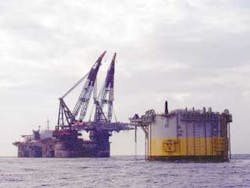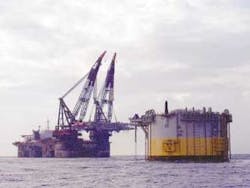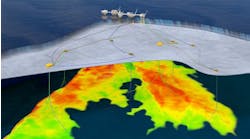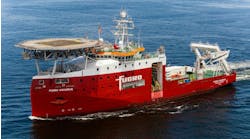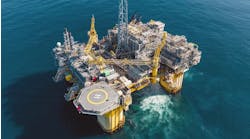Heerema sets heavy lift record in the Gulf of Mexico
Judy Maksoud
International Editor
The limits of today's technology constantly challenge the oil and gas industry. Bigger and more complex deep-water production options make this particularly true for heavy lift activities.
According to Hein Mulder, CEO for Heerema Marine Contractors, "The boundaries are constantly being pushed further and further out by our clients." The challenge for HMC and other companies is to find ways to help reach those boundaries.
BP contracted HMC to install four sizable Gulf of Mexico facilities. HMC is responsible for coordinating topsides installation for the Holstein, Mad Dog, Thunder Horse, and Atlantis facilities, two spars and two semisubmersibles, as well as export pipeline installation to the Mardi Gras system.
In carrying out the installation for Holstein, HMC set a heavy lift record with its vessel, DCV Thialf during the major lifts for the spar.
Dockwise's Black Marlin heavy transport vessel moved the Holstein spar hard tank 6,500 nautical mi from CSO Aker Rauma Offshore Oy in Pori, Finland, to Gulf Marine Fabricators in Ingleside, Texas. The 23,509-metric-ton tank was skidded onto the vessel transversely to create greater stability and was floated off at its destination.
HMC's Thialf lifted the topsides modules onto the Holstein spar.
According to Michel Hendriks, HMC project manager, the dry weight of the North module at 7,564 metric tons makes it the heaviest lift in this region.
"Although HMC has executed multiple installation operations with lifts of above 10,000 metric tones in a DP mode on fixed structures, this was the first carried out on a spar," Hendriks says.
Perfecting the process
In preparation for big lifts such as the Holstein topside structures, HMC performs a number of checks. At a minimum, the company checks the in-house rigging design and carries out a full verification of all lift points and primary members of the structure, Hendriks says. There is also a full dynamic study of the lift vessel, the lifted structure, and the spar. "We check the relevant stability figures for all phases and perform a full DP simulation of the entire operation, including the use of HMC-developed 'Heavy Lift Mode' features," Hendriks says.
Prior to the actual operation, HMC does a full check of the lift vessel and all of its systems and performs and records all of the planned procedures.
null
Tough, extensive preparations are essential for a flawless operation, Hendriks says, and the experience of the offshore crew is a key factor in the overall success. "It is one thing to prepare the operation by visualizing it at your desk. It's something else to make the decision to start the lift operation in the middle of the Gulf of Mexico."
According to Hendriks, that is why the crew and its collective experience are critical factors in executing a lift of this magnitude. "Their participation in Hazids, for example, sharpens the proposed execution procedure and provides confidence that all aspects of the lifts are taken into account by the project team," Hendriks says.
Making the lift
HMC began the process of lifting the modules by mooring the cargo barge at the stern of the Thialf. Once that was done, slings were connected and the sea fastening cut. Next, the structure was lifted from the cargo barge, which was unmoored from the vessel. The Thialf moved to the spar, where the topside module was positioned above the deck and set in place. The next step involved transferring the deck weight from the cranes to foundation points on the spar by ballasting the Thialf. With that accomplished, the rigging was disconnected, and the Thialf moved offsite.
Handling the challenges
"The interaction between the floating vessel during the entire operation was a feature different from previous lift operations," Hendriks says. "We had to pay special attention to the inclination of the spar."
Wave and current movement presented another set of issues. The Holstein field is located in an area of the GoM affected by eddy and Loop currents. To mitigate possible downtime as a result of the currents, HMC decided to install additional power generation on the Thialf.
"Although increased current levels were observed during the operation, the lift was executed without any down time as a result of these increased currents," Hendriks says.
Hendriks says that though there were no specific obstacles or issues involved with this lift other than its record weight, there were discussions between HMC and the BP Holstein installation team about how to fully use the lift capacity. "There will always be discussions on balancing the crane capacity versus safety factors and structure size versus clearance between the lift structure and the lift vessel," Hendriks says.
With the record lift behind it, HMC has demonstrated the 14,000-metric-ton lift capacity of the Thialf to its full extent and in doing so has proven a cost effective field development solution, Hendriks says.
